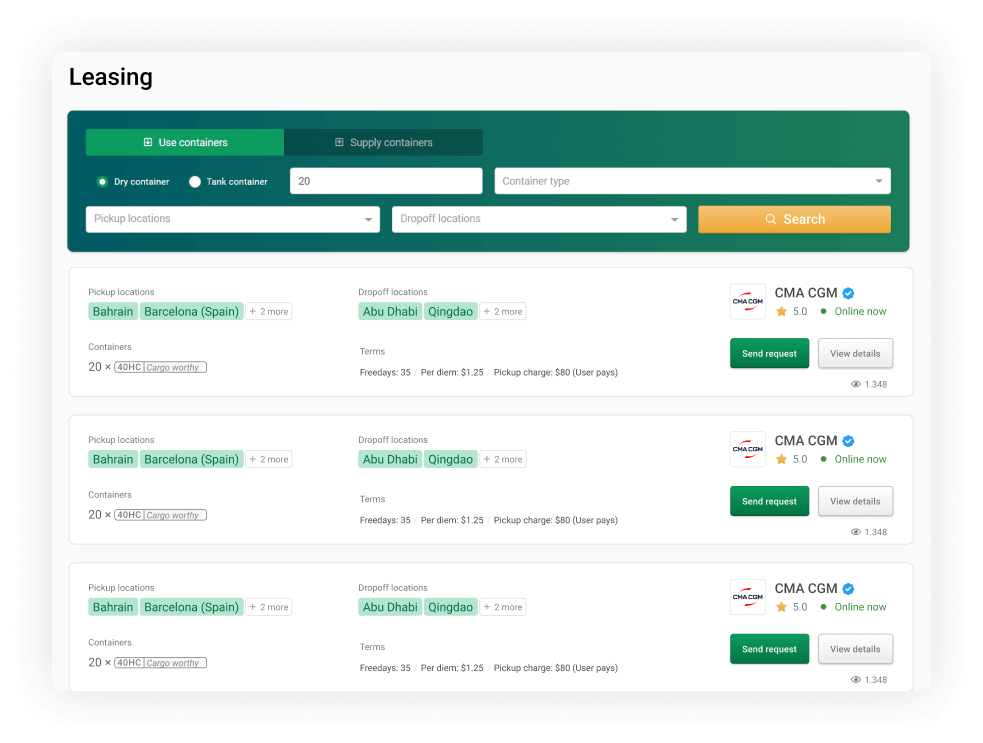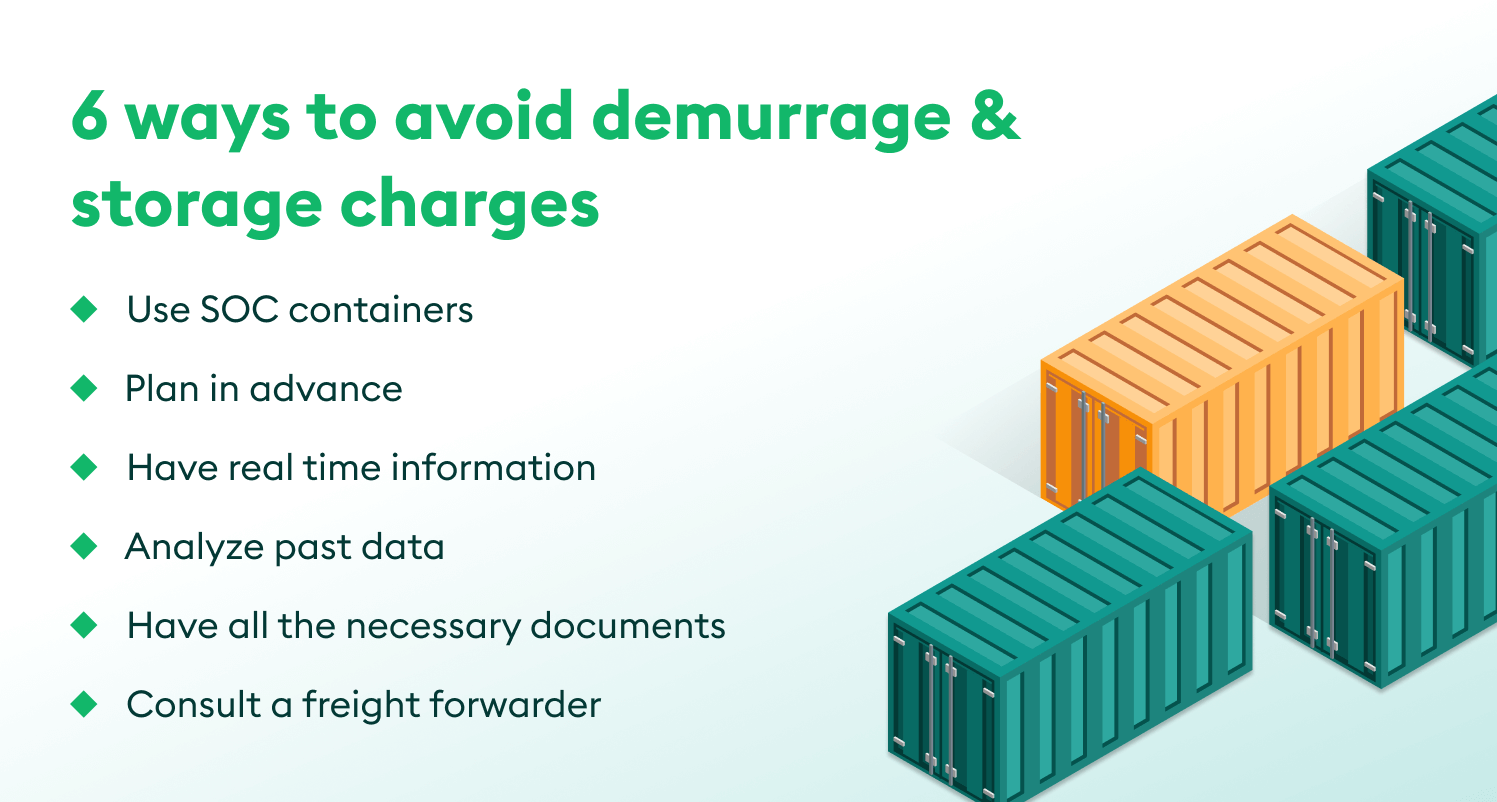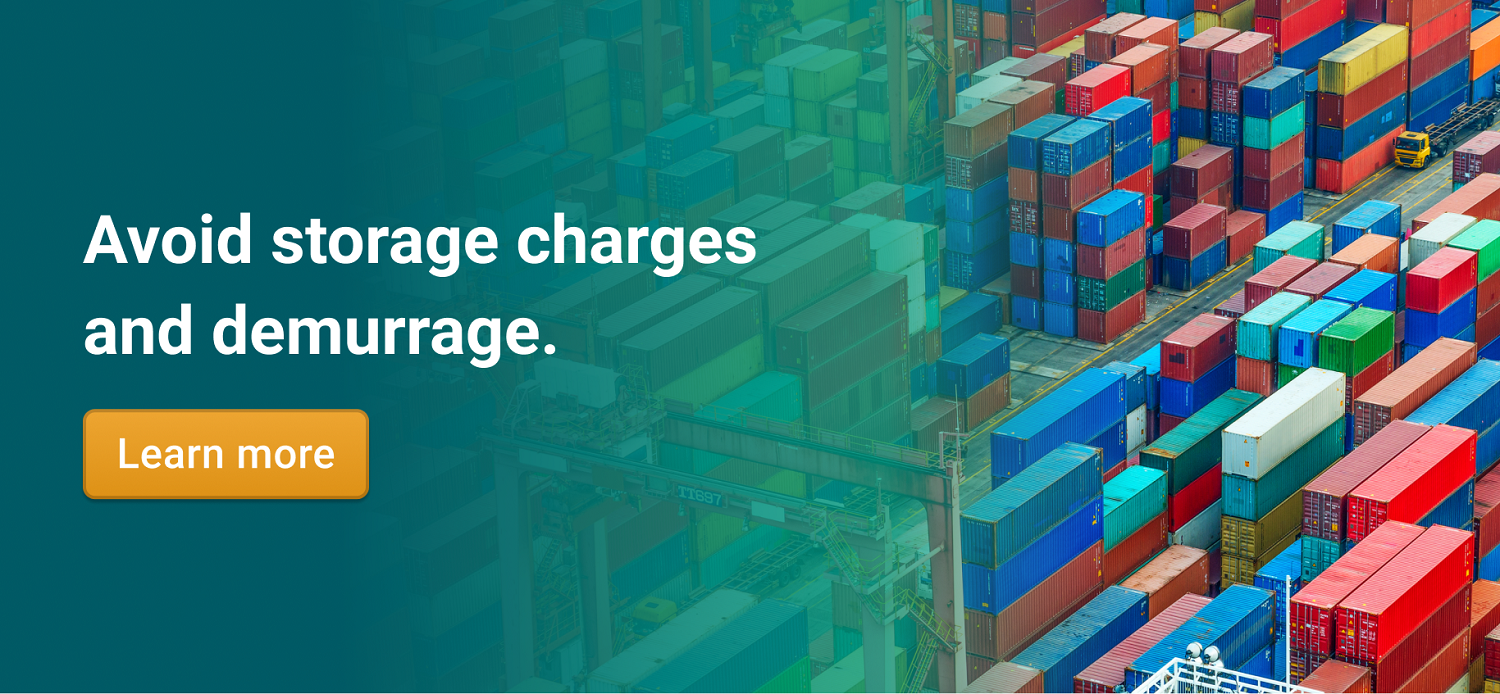Knowing the difference between demurrage and storage charges proves to be handy when it comes to shipping, this way you can better prepare and avoid unnecessary costs. This blog explains the stark contrast between the two and tells you 6 ways you can save and avoid them.
Every freight forwarder needs to know the difference between demurrage and storage charges while shipping any type of container or cargo. These charges can spike up the total costs of shipping and eat into their profit margins. The key to minimizing these charges is to understand what they mean, how they differ, and how they are plied.
Let’s say your shipment encounters an unexpected delay, prolonging its stay at the port. Panic sets in as you realize that each passing day inches you closer to the perilous realm of demurrage fees. The clock is ticking, and you must find a way to unload the cargo and escape the clutches of financial burden. You could store your cargo and avoid these fees, however, storage charges creep up on you and you’re left with no choice but to pay up.
There’s an easy way out here, and it’s called SOC containers. So, if you already know and understand the distinction between demurrage and storage charges, then you’ll know that SOC containers can help you avoid these extra costs. It’s best to get your hands on one as soon as possible. You can use our public search tool to find SOC containers easily.
Simply type in your location, the container you’re looking for and the drop off location you desire. Hit search and start browsing through the many options offered by vetted and secure suppliers.
What is demurrage?
Demurrage is the extra charge paid by the shipper for using the containers and related equipment. These charges are time-sensitive and start accruing once the allotted number of free days is over. So, essentially, if you’re running late with your containers, you might be expected to pay the demurrage fees (charged per day per TEU-20-foot equivalent unit).
It’s important to be mindful of when and how the container is being moved through the terminal since demurrage charges can keep increasing after the interval of a few days and can exceed US $100 per container per day.
Also, by charging demurrage, shipping lines can ensure that the containers and equipment are returned to them as soon as possible. Additionally, it helps free up space at the terminal or private depot, supporting a healthy flow of goods and avoiding congestion.
Note: These charges were initially introduced to provide fair compensation to the equipment, containers, facility owners, and shipping lines.
| Pro tip: Leasing SOC containers can help you increase flexibility in your freight bookings and avoid Demurrage & Detention charges. You can do this easily on Container xChange. |
With over 1,500 members in over 2,500 locations, you’ll be able to find and lease your SOC for one-way moves in no time at all! Click the banner below to reach out to our experts and manage your fleet minus the fuss.
What are storage charges?
Storage charges refer to the payment charged by the port to store containers at the terminal beyond the allotted free days. Port storage charges are collected for full containers uncleared for import, full containers yet to be shipped for exports, and empty containers within the port.
For both import and export, the storage charges period starts when the container enters the terminal or depot for storage and ends when it is picked up from the port.
While some ports treat demurrage and storage under the same charges, others charge them separately. Sometimes, the ports collect these charges from the shipping line itself. In this case, the shipping company may pass on the storage charges to you i.e. the customer.
These charges, though seemingly unnecessary, play a key role in keeping the port free of congestion. It maintains a certain level of productivity in the port/depot because customers are incentivized to move their containers as soon as possible and avoid delays.
What’s the difference between demurrage and storage charges?
On the surface, these two charges — demurrage and storage charges — might appear the same. Essentially, demurrage is a type of storage fee for your container being stuck within a terminal.
However, there is still a difference between demurrage and storage charges:
|
Demurrage charges |
Storage charges |
| Charged by the shipping lines when the free days are exceeded | The terminal charges storage fees once the container surpasses the given free-days |
| Carriers agree to free days so the containers can either be 1) moved out of the terminal to be unpacked or 2) get the container loaded onto the vessel | When a container is offloaded, the ports offer a certain number of free days for the box to stay at the port or terminal premises |
| If the container is static at the port or terminal, you’ll be charged demurrage if a mistake has been made on your behalf | When the box is static at the port or terminal and you’ve exceeded the free days, you’ll be charged storage fees |
Other than knowing what sets these two apart, it’s also vital to be aware of what financial implications they might have on you or your business. Take a look at what these charges might cost you:
How much can demurrage and storage charges cost you?
The landscape of D&D is changing, and the recently published 4th edition of our demurrage and detention report gives you a thorough understanding. Here’s a quick run-through of the results we found:
- It was recorded that the Port of Los Angeles can charge as high as $2000 after two weeks of delay; while the Busan port would charge as little as $40 per TEU.
- Average D&D drops by 25% YoY, and even 14% lower than 2020. This is looking good for shippers – and feels like things are going back to normal.
- However, 11 ports exhibit D&D fees that are still higher than in 2020. These include Antwerp, Jebel Ali, Ningbo, Port Kelang, Rotterdam, Shenzen, Singapore, Tianjin, Xiamen, Hong Kong and Guangzhou.
Despite some relief for D&D in 2023, it’s a given that the shipping industry tends to remain volatile and quite unpredictable. If you want to explore more in-depth about current D&D charges, click the banner below to download our report.
The delay can occur due to a multitude of reasons, including but not limited to:
- Bad weather
- Labor strikes
- Port congestion
- Shortage of trucks or chassisWhat is a chassis? Chassis, in freight & logistics, refers to a skeleton framework with wheels on it used to move containers. It is also called intermodal chassis or container chassis. Similar to ... More
- Delays in customs clearance
- Incorrect documentation
- Delays in shipping
- The late release of shipments at the port
Examples of demurrage and storage charges in two popular ports:
There is a difference between demurrage and storage charges at different ports globally. They also differ according to shipping lines, cargo, and container type. Here are some examples of dry cargo based on an average from over the past 4 years (2020-2023)
Port of Long Beach (The US)
|
Demurrage Charges (per day/per TEU) |
Storage Charges (per day/per TEU) |
||
|
Free time |
4 working days |
Free days |
6 working days |
|
1-4 days |
USD 237 | 1-5 days |
USD 14 |
|
5-9 days |
USD 280 | Every additional day |
USD 28 |
|
10+ days |
USD 332 |
||
Port of Busan (South Korea)
|
Demurrage Charges (per day/per TEU) |
Storage Charges (per day/per TEU) |
|
|
Free days |
12 working days |
USD 0.092 |
|
1-10 days |
USD 2.3 |
|
|
11-20 days |
USD 10.2 |
|
While most ports have different demurrage and storage charges, some countries don’t.
Ports in Japan and Saudi Arabia consider both the charges to be the same. There are also ports such as Busan in South Korea that charge a combined demurrage and storage fee. It’s important to verify these details with the port authorities and the shipping line before signing the contract to accurately gauge the total shipping expenses.
Reasons for the difference between demurrage and storage charges
Demurrage and storage charges can quickly eat away at profits and strain budgets, especially when shipments are delayed. Here are some reasons for these charges:
- Storage charges – Since most ports have limited storage available, they require the customers to move their cargo out of the port’s storage facilities as soon as possible. Levying a port storage charge helps avoid port congestion by charging for delays. It compels the consigneeWhat is a consignee? When transporting freight (by ocean, air, or land), there are two parties involved — one who is shipping and the other who is receiving the freight. The recipient of the goods b... More to clear all the documentation and get the container sent out for delivery quickly, freeing up port space.
- Demurrage charges – By charging demurrage, shipping lines ensure that the containers have a healthy turnaround time and avoid delays from the consignee’s end. These charges can add up to exorbitant values.
Before being levied, you’re allocated certain free days — during which the container should be moved to/from the terminal or storage facility. But, if you exceed the free days, it’s possible to be charged with both storage and demurrage.
Since demurrage and storage charges are usually the results of unwarranted delays, the entire supply chain can get disrupted. That’s why it’s beneficial to know how to avoid them.
6 ways to avoid demurrage and storage charges
Now that you understand the reasons behind the difference between demurrage and storage charges, let’s explore six practical ways to avoid these fees and keep your logistics costs under control:
- Use SOC – When you lease SOC containers, you borrow empty containers from an owner who’s looking to move containers from a surplus to a deficit area — thus, saving the container owner money on storage and repositioning.
- Plan in advance – Planning your shipment allows you to allot buffer periods in case of delays and also informs all the stakeholders well in advance. This minimizes the risk of paying demurrage and storage.
- Have real-time information – Track the shipment’s live location means to spare yourself from unwanted surprises. Reliable tracking data enables you to take proactive decisions and not reactive ones.
- Analyze past data – Digitization also helps you create records of all the necessary data points. These data points like weather, route, transit time, etc. are turned into valuable insights. They’ll help you analyze where, when, and why delays usually happen along the course of your shipment
- Be ready with your documents – Your container may face delays due to incomplete documents. Make sure you have all the right documents and papers needed for customs clearance like a bill of lading, commercial invoice, import/export license, arrival notice, etc. If possible, pre-clear your cargo to save time, and thus, additional charges.
- Consult a freight forwarder – Ocean freight shipment can be a time-consuming task. With steps like planning, documentation, communication with carriers/ships, finding the right equipment company, storage solutions, etc., it’s best to consult an expert freight forwarder to help you with the shipment.
Avoid demurrage and storage charges with Container xChange
The difference between demurrage and storage charges may indicate in terminology, but they have the same consequences when it comes to costing your company money. But the good news is you can avoid these charges with Container xChange – using SOC containers for a one way move- use SOC containers. You lease SOCs from owners who want to avoid empty repositioning costs. This way they save money and you can also avoid paying high per diem charges in case you’re running late in delivering the container back.

More than 1500+ shipping companies in 2500+ locations worldwide are already using our online platform to find new partners and save time and money. You can become one of them too!
We have 10k+ transactions on our platform every month with 50,000 containers readily available at your fingertips. All the costs are stated upfront with no hidden charges or extra commissions, so you get 100% transparency through every transaction and interaction.
We help you get in touch with your preferred partner directly. Moreover, you can rest assured that you are only dealing with trustworthy partners because all our members go through a mandatory vetting process before they join us.
We also handle all your payments from the beginning so that you can take care of your business, crack new deals and grow your partner network.
Want to know more about how Container xChange can help you improve your business and save money on demurrage charges? Then click on the banner below and get a demo to see how this works first-hand!
 Difference Between Demurrage And Storage: Common FAQs
Difference Between Demurrage And Storage: Common FAQs
What is the difference between demurrage and storage charges?
Demurrage is charged by the shipping line for using its containers, equipment, and other facilities. On the other hand, storage is charged by the port authorities themselves when containers are stored inside the port/terminal.
What are demurrage charges?
Demurrage refers to the charge that is made when consignees use containers and related equipment within the port's terminal. It is charged by the shipping line to the customer on a per-day-per-TEU basis after the allotted free days are over.
What do storage charges mean in shipping?
Storage charges are collected by the port authorities from the shipping lines — who pass on the costs to the customers. These charges are meant for the usage of storage space inside the terminal.







